Water crossings are one of the most exciting parts of the motorcycle off-roading experience! Of course, it can be a scary experience, especially if you’re not from the hills and not used to the enthusiasm of water flowing across a sharp road at dizzying heights!
Even when you’re crossing rivers to get to the other side (the thrill is kind!), it might be a frightening thought, especially for first-timers! Yes, your senses become very alert when you’re nearing a water crossing – and rightfully so!
Let's quickly dive into the details:
Tips for tackling water crossing on Himalayan trips
Often you’ll see that there can be long lines waiting to cross the difficult water flowing across the road and a line even after crossing the section. Even the Experienced riders are a little cautious.
These delays make sense as riders are always in two minds before the water crossing and after crossing – and your vehicle will require a lot of checks to ensure nothing untoward has happened, which might be a pain afterward.
For instance, a rider might need to assess the situation for any water in the engine – and mixing with oil can quickly cause damage and reduce the life of your engine as well. Of course, getting drenched in cold water is never fun either.
So let us begin with what you’ll need to be aware of to calm your nerves!
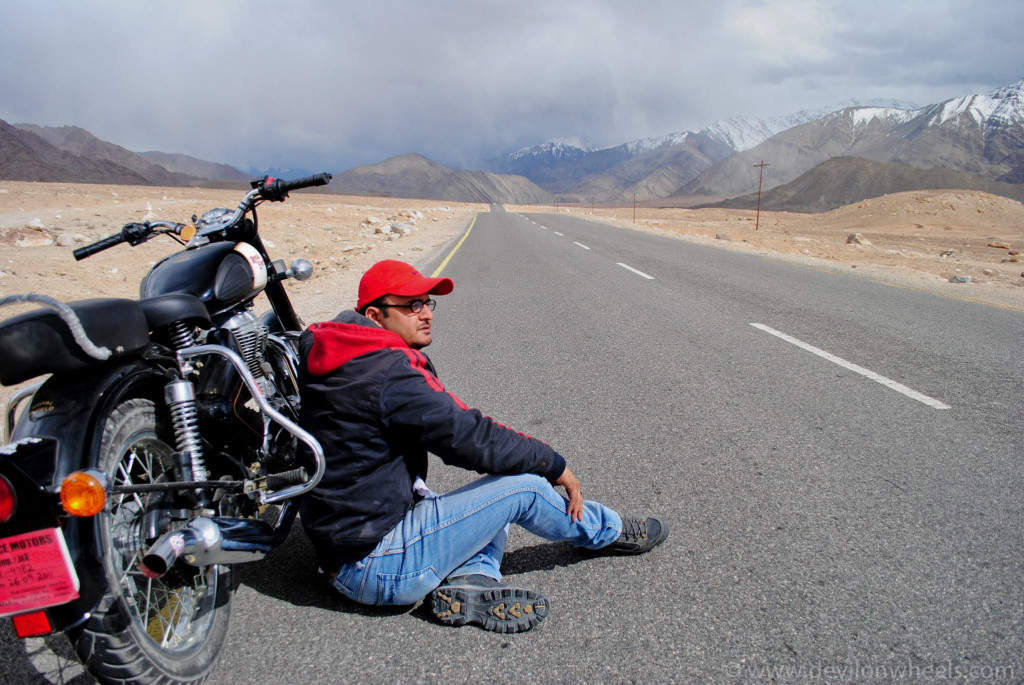
Approaching the Water Crossing
When you’re approaching the water-crossing, there are a bunch of things to keep in mind and follow up on!
Plan your travels well. With most typical water-crossing paths, a classic example being Gramphoo-Batal, you should aim to make the crossing as early in the AM as possible. With the sun rising, the snow melts faster, especially around noon. This snowmelt leads to a heavier flow of water, which increases the difficulty and intensifies the need for technique.
As an added security, you should avoid such trips during July-August, when the monsoon is at its peak. Also, if you reach the water crossing and it is raining, or the water flow is fast – avoid crossing then! Wait for the rain to stop or the water level to come down. It might consume some of your preciously planned hours. But, that is, of course, better than risking your life and bike!
When you’re at the water crossing, assess the situation, and make sure whether it is safe enough to cross. To do this, you can walk through the crossing to ascertain the situation. If you find the flow of the water to be too aggressive, such as the depth being too much or even the bottom of the crossing is mostly mud, sand, clay, submerged rocks, slime, logs, and deep holes – then it becomes very tricky!
As a caution – do note that water always looks shallower than it is. So, you may use a stick to give you a proper gauge of depth. In case you find the water too murky (probably due to other bikes/cars crossing), then wait for it to clear to determine the situation.
However, if you find that the river is over knee-deep and is flowing very fast, then it is better not to risk it and wait for it to calm down!
Don’t be over-confident. It is great if you have some experience (or are a pro even!) at water-crossing in the hills. The water is all-mighty and powerful; it has the power to break roads, wash away portions of the hills! Don’t risk it by being smug!
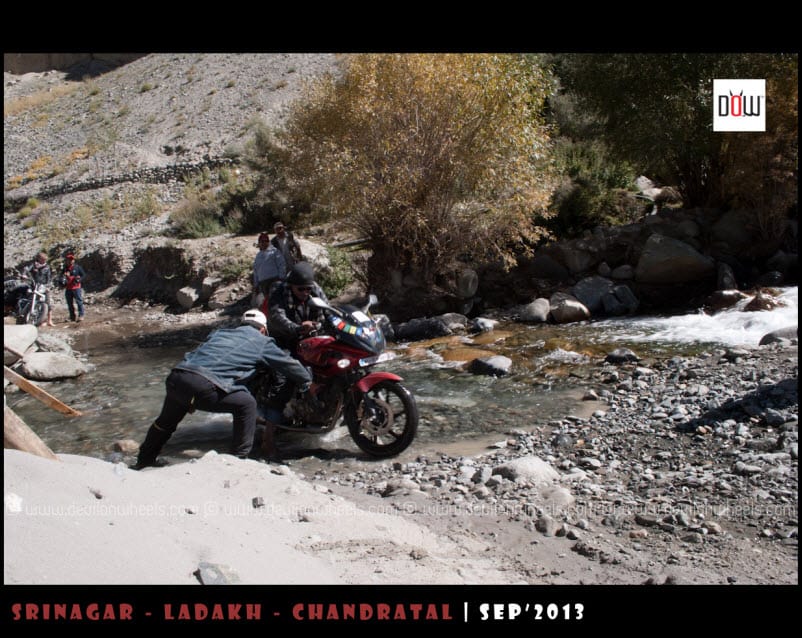
The beginning – how to start the water crossing
Now that you’ve determined the water is safe enough to cross, here’s what you’ll need to do –
Always wait for a few minutes before passing through any water crossing as a hot engine colliding with water can damage the engine. It might not be evident immediately, but you can get stranded in the middle of nowhere if the engine gets damaged!
If you have company, such as a pillion (or a co-passenger in the car), then they should guide you through the water but check the chosen line of the path for trickier portions.
Always wait aside when in doubt and see how others are crossing the water crossings. Always ensure you know a path and can visualize the route in your mind, which you need to trace while crossing it. Also, if you can see a defined path, set in place by other travelers – stick to that!
Riding on car tracks might be the best way, even if it happens to be the deepest part of the crossing. This point is especially true when you are crossing a riverbed with rocks! The car track would have jammed the rocks into each other, and the probability of loose pebbles is the least at car tracks.
Ask for help! Mountaineers and bikers are a helpful bunch. Don’t be hesitant in approaching the other bikers. Even the local villagers will take a few minutes of their day to ensure your safety.
If you get stuck somewhere, others can guide you through their vantage point. Also, don’t try water-crossing by yourself as loaded bikes are much heavier and tend to slip very easily. This slip can submerge your bike underwater or cause some injury.
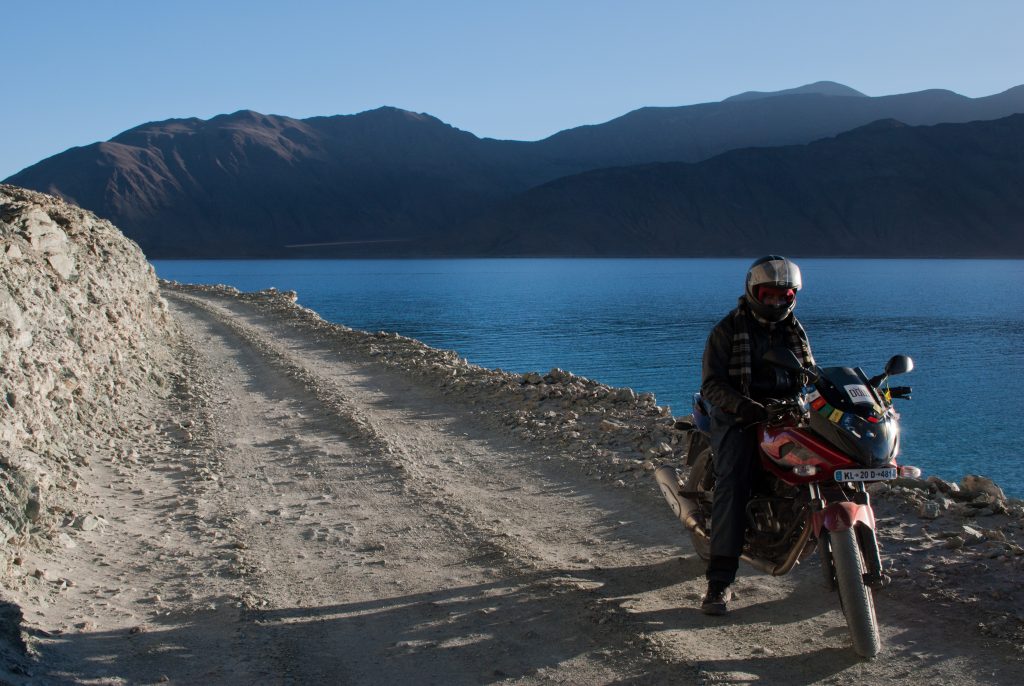
The act – actually crossing the water on your motorcycle
When you’re actually in the process of crossing the river, you need to be alert and aware. Reflex actions are important in case of any change in the calculated scenarios! It isn’t tough, but you need to be vigilant.
Maintain the speed of your motorcycle with which you start your journey. Stopping your vehicle might lead to it not restarting again, especially in a lot of water. My suggestion is that you start in the first gear and move slowly towards the crossing.
The speed should not be too fast, as it would lead to many competitive scenarios, such as you might splash water into your engine or exhaust vent, which will lead to your bike stopping. However, the speed should not be too slow. Snail-like speed might allow control – but there’s the risk of the bike stopping mid-stream.
Common practice theory is that you should stand up while crossing the water. Some riders believe that it provides better control of the bike and a better vision of the obstacles ahead. However, you may choose to sit steadily to provide balance, but keep your feet in the water – which will provide better control for the bike.
Another thing to keep in mind is the RPM. During water-crossing, most of the time, we end up losing traction on our rear wheel. A higher RPM helps in putting extra weight on the rear of the bike, thereby providing a better grip.
Choose a straight path: when you’re searching for a path, ensure that your route is as straight as possible. Maneuvering a bike through multiple bends, with the added challenge of water flow is an easy recipe for disaster!
Look through the rocks and debris and find a smooth, shallow path through the water to cross. Also, keep in mind that water moves slower in the deeper sections. Areas with broken water will be shallow, but also rockier. Crossing just upstream from the broken water should give you a clean line. You can also try staying within the tire tracks of heavy vehicles to get a smoother path.
If a river is particularly fast-flowing, the best approach is to start your journey on the motorcycle upstream and cross at an angle moving downstream. This trick will allow you to ride with the current instead of against it.
If the crossing seems difficult, the best way to cross it is, to walk the bike. Now, when I say walk the bike, I don’t mean pushing it from one side and getting off it. Just stand and use your throttle to steer the bike. This point is where shoes with a better grip make more sense than waterproof shoes.
Trying to push your bike from one side the way we do on normal roads won’t be a great idea here. As in most cases, when you throttle, the rear would tend to move away from you because you are trying to pull the front end towards you, and practically you don’t have any control over the rear wheel. This fact is even more accentuated in the water-crossing.
If at any moment you feel that you are losing your balance and there’s not much else you can do – then the best thing to do is to let your bike go! Yes, you might get water into the sensitive parts of your bike and have a lot of work to do afterward.
But, above all else, you don’t want to dislocate your wrist. The Royal Enfield is usually the Motorcycle of Choice when covering the Himalayas and the heavy bullets make it very likely that you would end up hurting your wrist.
Listen to your bike. Sometimes we stubbornly tend to control our bikes. But, bikes always obey physics and not us.
The End – what to do once you cross the water
Once you have crossed over, you’ll want to have a thorough check of the bike, especially the underbelly, to ensure everything is in order. Once you inspect it properly, reload your stuff onto your motorcycle before embarking on the trip ahead. Also, don’t forget to take a breather once you’re on the other side of an especially difficult water-crossing.
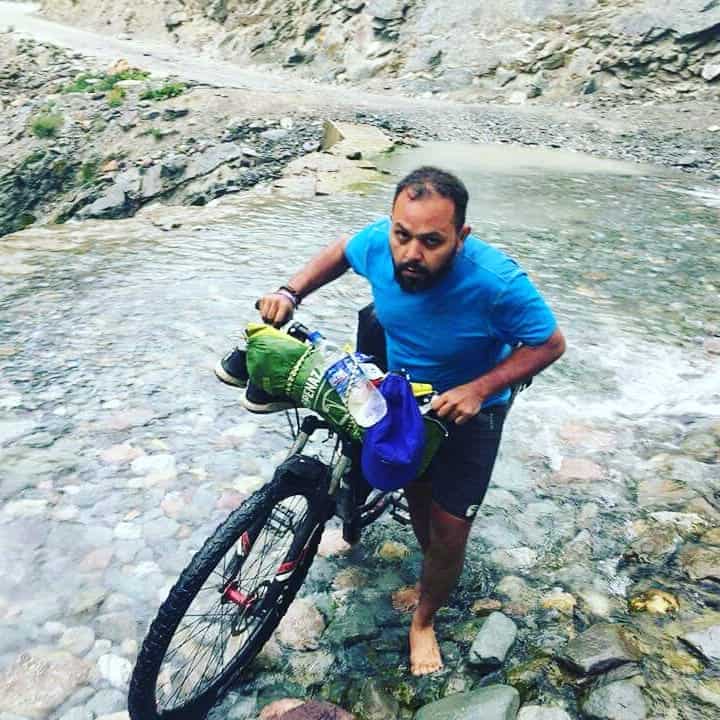
What to carry on the motorcycle trip to Ladakh or Spiti
When you’re crossing difficult water crossings, ensure you take off all the stuff on your motorcycle (or at least as much as possible) and get a co-fellow/ pillion rider/ others around you willing to help to get it safely to the other side.
If no one is around for help and you’re out on a solo excursion, then the safest option is to carry your stuff by foot to the other side! You don’t want your stuff to fall off. Consider if you have electronic gear on you – any water into your systems and their shot!
Do carry a First Aid Kit at all times when in the hills. Especially with water-crossings, you might get some bruises along the way! Quickly put on some ointments/ Band-Aids as needed, maybe!
Shoes are the most important thing when traveling on a motorcycle. Yes, waterproof shoes are great, but I truly believe grip comes over all else. No matter how waterproof a shoe might be, when you’re traversing through knee-deep water, water tends to seep in through lace vents, etc.
And, once your inner socks are wet, everything else becomes meaningless. I’ve tried everything from putting plastic bags to a knee to an array of shoes, but they all had their advantages and disadvantages.
The best thing in my experience is always to have 4-5 pairs of socks. Once you make the cross, change to a dry sock. Your shoes can be dried with a cloth if it’s waterproof. Before anything else, make sure you wipe your feet dry.
Always keep the Toolkit ready and Dry up the spark plug or Engine vent as soon as you cross the water crossing and don’t hurry forward. It is imperative to wait for a while and dry out the important components if needed. Meanwhile, you can always click some pictures of the crossing!
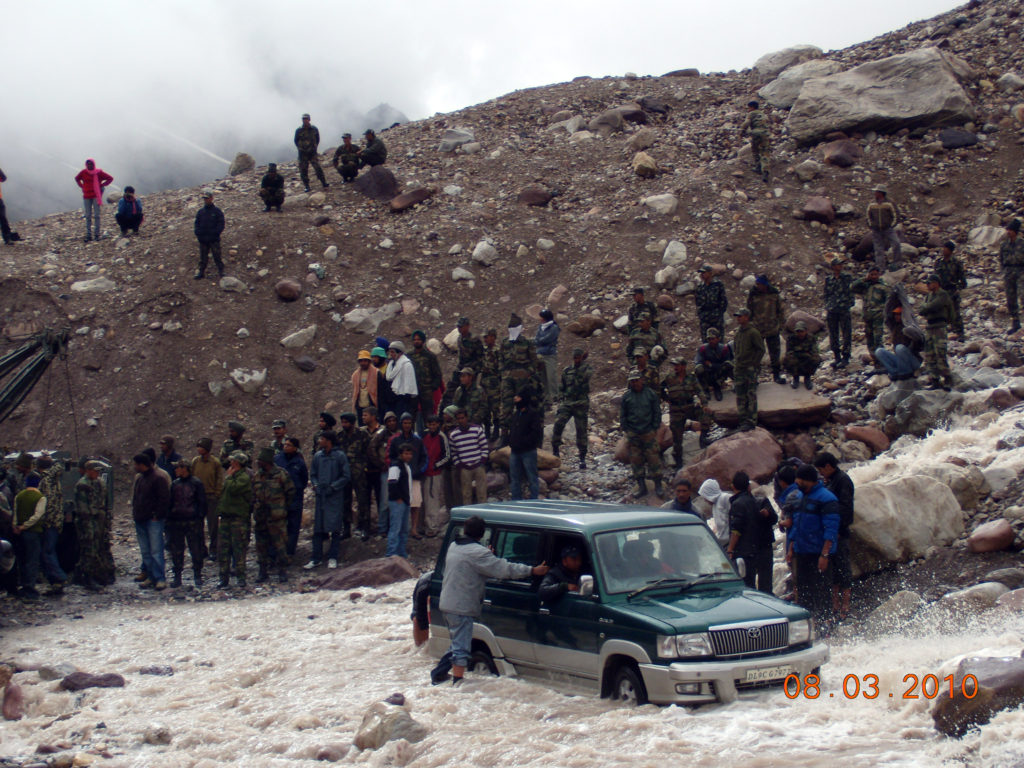
Other Articles in Spiti – Ladakh Bike Ride Series
- Preparing your bike for Ladakh or Spiti trip
- The Complete Guide: Long Distance Motorcycle Riding
- Packing List for long-distance motorcycle riding
- Safely Carrying Spare Fuel & Luggage on Motorcycle
- Tips for Cold Weather Motorcycle Ride in Ladakh or Spiti
- Clothes & Accessories to Carry on Ladakh Bike Ride
Conclusion
Preparation is better than cure, especially when you’re on a motorcycle, in the hills! You don’t want to go forward callously, and you should always be vigilant. Water-crossings are not tough if you’re aware of and apply the technique.
Have a travel question?? You can subscribe to my YouTube channel and leave a comment to ask your travel questions about traveling to the Himalayas.
If anything is not working, it is better to let it go rather than force a solution. Lastly, please be safe and exercise a lot of caution when partaking in such activities. Don’t be afraid to ask for help! But, most importantly, live in the moment and enjoy the experiences.
Are you an experienced mountaineer or biker traveler? Do you have any tips I have missed out on that might help fellow bikers out? If so, please do let me know below!





